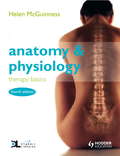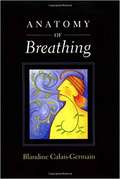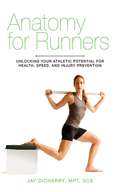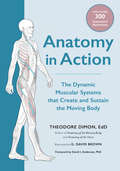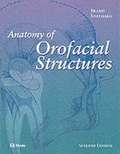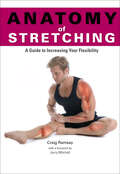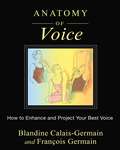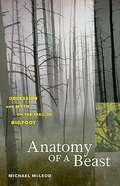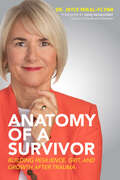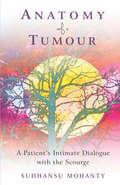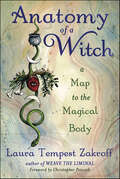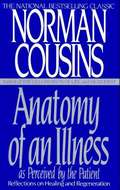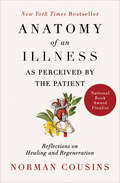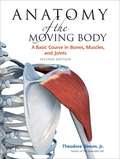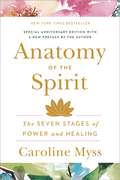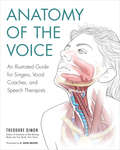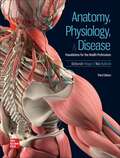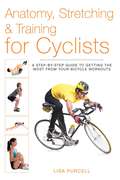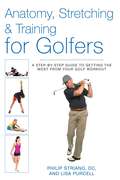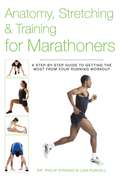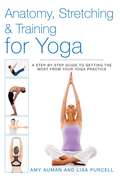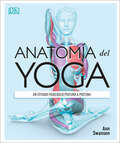- Table View
- List View
Anatomy & Physiology: Therapy Basics
by Helen McguinnessGive your students the accessible and authoritative introduction to anatomy and physiology they need with this bestselling textbook. This edition, written by a well-known expert in the field and known for the breadth and depth of knowledge it provides, is in line with all the latest specifications for all major awarding bodies of beauty therapy, complementary therapy and specialist diploma courses from Levels 1-3. It also provides a clear introduction to anatomy and physiology for students of complementary health, as well as essential knowledge for the Diploma in Hair and Beauty Studies. - Support understanding of complex structures and processes with illustrations, excellent reference material, lists of key words, clear learning objectives, chapter summaries and multiple-choice questions throughout - Relate theoretical knowledge to the real world with contextual links throughout - Use the accompanying student website which includes answers, interactive drag-and-drop labelling activities, multiple-choice questions and key-words activities.
Anatomy Of Breathing
by Blandine Calais-GermainMy hope is that [this book] will contribute to a more enlightened practice of breathing. I also hope that you, the reader, will have a better understanding of how breathing changes spontaneously from moment to moment. My other wish is that you will discover how to consciously choose a specific breathing technique for certain purposes or circumstances. -- Author s Preface Everyone breathes, yet few of us understand how to consciously control breathing to improve our well-being and the quality of many daily activities. Anatomy of Breathing is a clear and helpful guide to both the theory and practice of breathing in its many variations. Hundreds of expert drawings along with easy-to-understand text help you explore just how breathing works. Once you re acquainted with the principal organs, structures, and forces that affect breathing, you will learn how to control them to enhance the quality and variety of breathing in your own life. Along the way, you will also correct many common misconceptions about breathing. Anatomy of Breathing is filled with helpful practice pages. Here you will learn simple exercises to prepare your body for the benefits of different types of breathing. You will then be shown, step by step, how to practice some of the most common and useful breathing techniques on your own. Anatomy of Breathing is a unique and wonderful resource for anyone who wishes to understand the science and art of breathing, and how to make their own breathing better and more life-enhancing.
Anatomy and Physiology Coloring Workbook: A Complete Study Guide (7th edition)
by Elaine N. MariebThis guide is an excellent tool for use by itself or with any human anatomy and physiology book. The author's unique approach promotes and reinforces learning on many levels through a wide variety of visual and written exercises. In its review of the human body, from microscopic to macroscopic levels, the workbook covers the most important and useful aspects of human anatomy and physiology, and offers clinically oriented activities.
Anatomy for Runners: Unlocking Your Athletic Potential for Health, Speed, and Injury Prevention
by Jay DicharryRunning has become more and more popular in recent years, with thousands of people entering marathons, buying new running shoes with the latest technology, and going for a daily jog, whether on the track or on a treadmill. Unfortunately, with running comes injuries, as a result of wrong information and improper training. Author Jay Dicharry was tired of getting the same treatments from doctors that didn't heal his joint and muscle pain from running, so he decided to combine different fields of clinical care, biomechanical analysis, and coaching to help you avoid common injuries and become the best runner you can be. Along with clear and thorough explanations of how running influences the body, and how the body influences your running, this book answers many of the common questions that athletes have: Do runners need to stretch? What is the best way to run? What causes injuries? Which shoes are best for running? Is running barefoot beneficial? The mobility and stability tests will assess your form, and the corrective exercises, along with step-by-step photos, will improve your core and overall performance, so that you can train and run with confidence, knowing how to avoid injuries!
Anatomy in Action: The Dynamic Muscular Systems that Create and Sustain the Moving Body
by Theodore DimonAn illustrated guide to the core design principles of the body&’s musculoskeletal system—for kinesiologists, movement therapists, yoga teachers, dancers, and bodyworkers of all kindsWhat does knowledge of anatomical structure have to do with preventing everyday muscular aches, pains, and injuries? According to Dr. Theodore Dimon, everything!Our bodies are designed to work holistically, supported by an intelligently organized system of muscles, bones, and connective tissue. So when we target problem spots by stretching, relaxing, or strengthening individual muscles, we bypass the dynamic, interconnected network that enables healthy functioning and injury prevention. Understanding how this system works in action is the key.In this groundbreaking guide, Dr. Dimon describes the basic principles that govern our bodies&’ musculoskeletal architecture and provides practical exercises to activate specific muscle groups and demonstrate our bodies&’ efficient holistic function. Readers will learn about dynamic design and the body in action, including: • How the musculoskeletal system works as a whole • The relationship between proprioception and muscle length • About maximizing spinal, shoulder, hip, arm, and leg stability and health • The important role of breath and breathing • About posture and musculoskeletal support With more than 300 illustrations, this is an ideal resource for students and practitioners of kinesiology, bodywork, movement, sport kinesiology, dance, and all readers searching for a dynamic guide to the human body.
Anatomy of Orofacial Structures (Seventh Edition)
by Richard W. Brand Donald E. IsselhardThis comprehensive edition on orofacial structures provides a complete introduction with dedicated sections on dental anatomy,oral histology and embryology, head and neck anatomy.
Anatomy of Strength Training
by Pat ManocchiaWorking out can be fun and rewarding. But if you're not doing it correctly, it can seem pointless, and even painful. Knowing the best way to build muscle-and knowing why it's the best way-can mean the difference between a lifelong devotion to exercise and a fabulously fit body, or giving up in frustration.Health and fitness expert Pat Manocchia gives readers the tools they need to embark on a journey of fitness and health, from basic movements to information on how to build a complete exercise plan. With step-by-step instructions and easy-to-follow illustrations of starting positions and movement paths, it's like having your very own personal trainer.Learn what to do and what not to do. For example, hands should be shoulder-width apart during a chin-up, and you should never, ever swing the body during that move. Keep a slight arch in the back while performing a dead lift, and do so by keeping the head up. Find out how to get results by following these and other exercises.Anatomy of Strength Training brings a new dimension to workouts, helping readers target every problem area-and helping them stay on the path to health and fitness.
Anatomy of Stretching: A Guide to Increasing Your Flexibility (Anatomies Of Ser.)
by Craig RamsayIt doesn't matter if you're a fitness novice or an elite athlete. You should be starting each workout exactly the same way - with a stretching regimen designed to warm up your body and help you achieve a new personal best each time. But without the expertise of a professional trainer and without an expert's understanding of muscle anatomy, it can be hard to know what exercises are best.Craig Ramsay is here to help! In Anatomy of Stretching, he brings the lessons learned in ten years as a trainer to celebrities and professional athletes and the star of Bravo's Thintervention to everyone. You'll learn when and how to do a tricep stretch and a shoulder stretch, when to avoid toe touches and hamstring stretches, and why it's important to keep your neck relaxed during a hip flexor stretch. While taking you through each movement step by step, Anatomy of Stretching also goes beneath the skin to allow you to see just which muscles you are working during each stretch.Get limber - and get the most out of your workout - with Anatomy of Stretching!
Anatomy of Voice: How to Enhance and Project Your Best Voice
by Blandine Calais-Germain François GermainAn illustrated guide to the dynamic physiological structures that create and individualize the voice • Explores the structures of the vocal tract and their functional relationships to the entire musculoskeletal system with detailed drawings • Examines the components of the larynx and pharynx, the effects of muscular tensions on the vocal cords, the importance of skeletal alignment, and the complex roles of the diaphragm, soft palate, lips, and tongue in vocalization • Provides exercises and techniques for increased air flow, correct posture, proper tongue position, jaw relaxation, and toning of the soft palate to improve the voice When we use the voice, we involve the entire body. Our internal balance, muscular tone, skeletal alignments, soft tissue flexibility, and even our eye movements are reflected in the voice we project to our audience, whether one person or thousands. Using the signature anatomical style of Blandine Calais-Germain’s groundbreaking book Anatomy of Movement, this illustrated guide presents a dynamic, integrated study of the physical structures of the vocal tract and their functional relationships to the entire musculoskeletal system. From the individual bones and muscles of the head and neck to the intricate structure of the shoulders to the abdominal muscles and pelvis, the authors explain how each part of the body moves, flexes, vibrates, and supports the creation and individualization of the voice. With detailed drawings and clear, concise text, they examine the individual components of the larynx and pharynx, the effects of muscular tensions on the vocal cords, proper alignment of the skull, rib cage, and pelvis, the intimate relationship between breath and voice, and the complex roles of the diaphragm, soft palate, lips, and tongue in vocalization. They provide simple exercises and techniques for increasing air flow and force, correct posture, proper positioning of the tongue, relaxation of the jaw, and toning of the soft palate. Whether singer, teacher, actor, lawyer, politician, or workshop leader, this book reveals how understanding your vocal anatomy enables you to express your best voice.
Anatomy of a Beast: Obsession and Myth on the Trail of Bigfoot
by Michael McleodPart history, part road trip, and part biography, this is the true story of a remarkable group of men whose obsession with Bigfoot turned the giant hominid into an American icon.
Anatomy of a Survivor
by Dr Joyce Mikal-FlynnIn 1990, after a sudden cardiac event, Joyce Mikal-Flynn was dead for twenty-two minutes. While CPR and determined doctors returned her to life, she came to find that this new life wasn’t her life at all. Faced with depression, personal and professional setbacks, she ultimately recognized that this was not an end point—but a beginning. Over time, she understood that taking control begins with the essential choice to move forward. Her struggles fueled her. You got this, she told herself with every obstacle, failure, and misstep. <P> Trauma and crisis are inescapable aspects of life. Framed, at times, as something to get over, trauma never fully leaves those who experience it. For over two decades, Dr. Mikal-Flynn has worked with and studied issues faced by survivors. She understands and recognizes their desire to move forward, identifying specific mindsets and behaviors that encourage progress. Making the choice to move forward, fierce determination, and well-researched actions are key for survival and growth. <P> Interlacing stories with research on genetics, posttraumatic growth, and the neuroscience of resilience and happiness, this book outlines how survivors of trauma structure a positive and productive response. An ingenious strengths-based rehabilitation system—metahabilitation—engages them by uncovering and developing their resilience, grit, and capacity for growth after trauma. This book shows you how survivors are built and presents a unique system guiding them forward.
Anatomy of a Tumour: A Patient's Intimate Dialogue with the Scourge
by Sudhansu MohantyThe patient is Sudhansu Mohanty, an Indian civil servant in his early fifties; his scourge is the carcinoid tumour which, unknown to him, he has been carrying around for some time Mohanty’s introduction to this ‘scourge’ was gradual - starting with an almost-continuous fatigue, followed by intermittentdiarrhoea, a loss of appetite, enhanced perspiring, especially while eating, and a wasting away of muscles. He ignored them all, he lived in denial. Before he knew it, he was overtaken by nemesis in the form of a sharp drop in his haemoglobin. The cause is carcinoid - a rare form of cancer, rare in terms of appearance, hard to detect in its nascent stages, and, therefore, all the more deadly. In Mohanty’s case, it was suspected early, post-colonoscopy, thanks to the perspicacity of his gastroenterologist who – most unusual for a physician - pronounced: ‘I consider this malignant. I want to go in and see.’ The author takes the reader on his four-year-long odyssey with carcinoid, the rogue cancer. He touches lightly on his back-to-back surgeries and experiences in the hospital. He describes alternative remedies for cancer - eating asparagus, broccoli, lime, lemon grass - suggestions forwarded to him by well-wishers. He uses the Internet and finds the stories of fellow-sufferers. He narrates his ‘battles’ to ‘live’ life full tilt: holding down a demanding day job while he undergoes a third surgery; and, as though nothing has interrupted his life, even contemplates a sabbatical in a US university. Anatomy of a Tumour is a tale of courage and hope. Mohanty’s writing is imbued with both humour and courage, and clearly reflects his determination to face all odds with the same ‘gung-ho’ spirit that has informed his life.
Anatomy of a Witch: A Map to the Magical Body
by Laura Tempest ZakroffEmbodied Witchcraft for Wisdom, Connection & PowerThis book is a guide to the most magical tool in your possession—your body. Not just your physical flesh-and-blood body, but also your symbolic Witch body, the conduit for bringing the material and metaphysical worlds together. Within these pages, you will explore hands-on magical practices, exercises, and sigils related to your Witch Lungs, Heart, Bones, Mind, and the spiraling path of your inner Serpent.Magic flows most freely when you are in tune with your intuition and the power of your true self. Through dozens of activities, prompts, spells, and rituals, Anatomy of a Witch helps you connect with the seen and unseen worlds, your ancestors, and your living community. Discover the profound correspondences between your body, the mythos of tarot, and the five elements. Practice rituals and activities for protection, warding, rebalancing your home, and embracing your body, despite the limiting beliefs that society foists upon us. This book teaches you how to tap into your personal power as you make a pilgrimage to the inner workings of your true self.Includes a foreword by Christopher Penczak, bestselling author of The Temple of Witchcraft series
Anatomy of an Epidemic: Magic Bullets, Psychiatric Drugs, and the Astonishing Rise of Mental Illness in America
by Robert WhitakerIn this astonishing and startling book, award-winning science and history writer Robert Whitaker investigates a medical mystery: Why has the number of disabled mentally ill in the United States tripled over the past two decades? Every day, 1,100 adults and children are added to the government disability rolls because they have become newly disabled by mental illness, with this epidemic spreading most rapidly among our nation’s children. What is going on?<P><P> Anatomy of an Epidemic challenges readers to think through that question themselves. First, Whitaker investigates what is known today about the biological causes of mental disorders. Do psychiatric medications fix “chemical imbalances” in the brain, or do they, in fact, create them? Researchers spent decades studying that question, and by the late 1980s, they had their answer. Readers will be startled—and dismayed—to discover what was reported in the scientific journals.<P> Then comes the scientific query at the heart of this book: During the past fifty years, when investigators looked at how psychiatric drugs affected long-term outcomes, what did they find? Did they discover that the drugs help people stay well? Function better? Enjoy good physical health? Or did they find that these medications, for some paradoxical reason, increase the likelihood that people will become chronically ill, less able to function well, more prone to physical illness? <P> This is the first book to look at the merits of psychiatric medications through the prism of long-term results. Are long-term recovery rates higher for medicated or unmedicated schizophrenia patients? Does taking an antidepressant decrease or increase the risk that a depressed person will become disabled by the disorder? Do bipolar patients fare better today than they did forty years ago, or much worse? When the National Institute of Mental Health (NIMH) studied the long-term outcomes of children with ADHD, did they determine that stimulants provide any benefit? <P> By the end of this review of the outcomes literature, readers are certain to have a haunting question of their own: Why have the results from these long-term studies—all of which point to the same startling conclusion—been kept from the public? <P> In this compelling history, Whitaker also tells the personal stories of children and adults swept up in this epidemic. Finally, he reports on innovative programs of psychiatric care in Europe and the United States that are producing good long-term outcomes. Our nation has been hit by an epidemic of disabling mental illness, and yet, as Anatomy of an Epidemic reveals, the medical blueprints for curbing that epidemic have already been drawn up.
Anatomy of an Illness as Perceived by the Patient: Reflections on Healing and Regeneration
by Norman CousinsAnatomy of an Illness is the story of Norman Cousins and his successful fight against a crippling disease. It is the story of a partnership between a physician and a patient in beating back the odds. The doctor's genius lay in helping the patient use his own powers -- laughter, courage and tenacity. The patient's talent was in mobilizing his body's own natural healing resources -- in proving what powerful weapons all the positive emotions can be in the war against disease.
Anatomy of an Illness as Perceived by the Patient: Reflections on Healing and Regeneration
by Norman CousinsNational Book Award Finalist: The &“amazing&” New York Times bestseller about the power of laughter and optimism in fighting serious illness (Chicago Sun-Times). Norman Cousins&’s iconic firsthand account of victory against terminal disease, Anatomy of an Illness as Perceived by the Patient inspired a revolution, encouraging patients to take charge of their own treatment. A political journalist and activist, Cousins was also a professor of medical humanities at UCLA, where he studied the biochemistry of human emotions and their relationship to healing. When Cousins was hospitalized with a debilitating collagen illness, he decided to take his health into his own hands. Cousins and his doctor combated the disease together by creating a regimen of laughter and vitamin C specifically calibrated to his needs. Against all odds, the treatment worked, proving to Cousins that a positive attitude was key to his improvement. Years later, Cousins set pen to paper to tell the story of his recovery. In this humorous and insightful account, Cousins analyzes his own journey in relation to holistic medicine and discusses the astounding power of mind over body. The result is an inspirational and educational guide to health that continues to offer hope to many. This ebook features an extended biography of Norman Cousins by his daughter, Sarah Cousins Shapiro.
Anatomy of the Moving Body, Second Edition: A Basic Course in Bones, Muscles, and Joints
by Theodore Dimon John QualterLearning anatomy requires more than pictures and labels; it requires a way "into" the subject, a means of making sense of what is being shown. Anatomy of the Moving Body addresses that need with a simple yet complete study of the body's complex system of bones, muscles, and joints and how they function. Beautifully illustrated with more than 100 3D images, the book contains 31 lectures that guide readers through this challenging interior landscape. Each part of the body is explained in brief, manageable sections, with components described singly or in small groups. The author doesn't just name the muscles and bones but explains the terminology in lay language. Topics include the etymology of anatomical terms; origins and attachments of muscles and their related actions; discussion of major functional systems such as the pelvis, ankle, shoulder girdle, and hand; major landmarks and human topography; and structures relating to breathing and vocalization. This second edition features all-new illustrations that use a 3D digital model of the human anatomical form. The book's thoroughness, visual interest, and clear style make it ideal for students and teachers of the Alexander and Feldenkrais techniques as well as for practitioners of yoga, Pilates, martial arts, and dance.
Anatomy of the Spirit: The Seven Stages of Power and Healing (Orient Express Ser.)
by Caroline MyssAnatomy of the Spirit is the boldest presentation to date of energy medicine by one of its premier practitioners, internationally acclaimed medical intuitive Caroline Myss, one of the "hottest new voices in the alternative health/spirituality scene" (Publishers Weekly). Based on fifteen years of research into energy medicine, Dr. Myss's work shows how every illness corresponds to a pattern of emotional and psychological stresses, beliefs, and attitudes that have influenced corresponding areas of the human body. Anatomy of the Spirit also presents Dr. Myss's breakthrough model of the body's seven centers of spiritual and physical power, in which she synthesizes the ancient wisdom of three spiritual traditions-the Hindu chakras, the Christian sacraments, and the Kabbalah's Tree of Life-to demonstrate the seven stages through which everyone must pass in the search for higher consciousness and spiritual maturity. With this model, Dr. Myss shows how you can develop your own latent powers of intuition as you simultaneously cultivate your personal power and spiritual growth.By teaching you to see your body and spirit in a new way, Anatomy of the Spirit provides you with the tools for spiritual maturity and physical wholeness that will change your life.
Anatomy of the Voice: An Illustrated Guide for Singers, Vocal Coaches, and Speech Therapists
by Theodore Dimon G. David BrownThe first comprehensive, fully-illustrated approach to the voice that explains the anatomy and mechanics in detailed yet down-to-earth terms, for voice users and professionals of all kindsThis book is the first to explain, in clear and concise language, the anatomy and mechanics of the mysterious and complex bodily system we call the voice. Beautifully illustrated with more than 100 detailed images, Anatomy of the Voice guides voice teachers and students, vocal coaches, professional singers and actors, and anyone interested in the voice through the complex landscape of breathing, larynx, throat, face, and jaw. Theodore Dimon, an internationally recognized authority on the subject, as well as an expert in the Alexander Technique, makes unfamiliar terrain accessible and digestible by describing each vocal system in short, manageable sections and explaining complex terminology. The topics he covers include ribs, diaphragm, and muscles of breathing; the intrinsic musculature of the larynx, its structure and action; the suspensory muscles of the throat; the face and jaw; the tongue and palate; and the evolution and function of the larynx.
Anatomy, Physiology, and Disease: Foundations for the Health Professions
by Deborah Roiger Nia BullockRoiger and Bullock’s unique pedagogical and visual approach helps students make the important connections between systems and learn how the body functions normally in homeostasis, and how disruption of homeostasis leads to disease and disorder. With a straightforward, engaging writing style, the authors explain difficult concepts in the context of routine activities, making concepts easier to grasp. Measurable learning outcomes throughout the textbook, workbook, and digital learning and assessment program help direct students through the content so there are no surprises. Anatomy, Physiology, Disease requires no prior knowledge of chemistry or cell biology, and is designed for an anatomy and physiology course or an anatomy, physiology, and pathology course. It is neither too high nor too low and can be customized to accommodate the organization of individual courses.
Anatomy, Stretching & Training for Cyclists: A Step-by-Step Guide to Getting the Most from Your Bicycle Workouts (Anatomy, Stretching & Training)
by Lisa PurcellFull of Exercises, Training Tips, and Injury Remedies That Every Cyclist and Coach Should Have!Every year, more and more people take up cycling to get in shape and stay fit. Thousands of people are buying new bikes with the latest technology, entering races, and even forgoing rush hour traffic and crowded public transportation to ride to work. But the joy and thrill of cycling are often marred by injuries that can bother you for a few weeks or for years. That's why every cyclist needs to have Anatomy, Stretching & Training for Cyclists. Lisa Purcell includes a detailed exercise program that is designed for cyclists from beginner to advanced levels and that is devised to strengthen and stretch the major muscle groups used in cycling. She provides answers and tools for training, including: Step-by-step photos Tests to assess your form An assessment of cycling gear Exercises to improve your core The truth about stretching And much more!Featured are targeted stretches to increase flexibility and a wide-ranging selection of exercises that thoroughly strengthen the legs and arms and build both core strength and stability, as well as hone your balance and posture on the bike. A handy guide lets you know which muscles are the main targets of each exercise, as well the exercise's benefits and cautions, along with tips on perfecting your form. With a series of sample workouts that show you how to devise a training program to suit your unique goals, Anatomy, Stretching & Training for Cyclists is the ultimate reference for anyone wanting to achieve optimal cycling fitness.
Anatomy, Stretching & Training for Golfers: A Step-by-Step Guide to Getting the Most from Your Golf Workout (Anatomy, Stretching & Training)
by Philip StrianoWith training tips, exercises, and injury remedies, this is a book that every golfer and coach should have!There are few things more satisfying than a great round of golf. But the joy and thrill of golf are often marred by injuries that can bother you for weeks and ruin your game. A strong, fluid golf swing uses muscles in the legs, hips, lower back, and shoulders-all areas prone to serious, painful injury. That's why every golfer needs to read Anatomy, Stretching & Training for Golfers, which offers expert advice on how to maximize your game without the risk of getting hurt.Taking you through stretches that both warm you up before a game and cool you down after, Dr. Philip Striano focuses on working the primary muscles involved in the mechanics of the golf swing-stance, backswing, transition, downswing, and follow-through-as well as the secondary muscle groups that help support and balance you. Alongside each exercise are detailed, true-to-life anatomical illustrations showing which muscles of the body are targeted. A handy guide lets you know the exercise's benefits and cautions, along with tips on perfecting your form.With a series of sample workouts that show you how to devise a training program to suit your unique goals, Anatomy, Stretching & Training for Golfers is the ultimate reference for anyone wanting to improve their game by improving their fitness.
Anatomy, Stretching & Training for Marathoners: A Step-by-Step Guide to Getting the Most from Your Running Workout (Anatomy, Stretching & Training)
by Philip Striano Lisa PurcellWith training tips, exercises, and injury remedies, this is a book that every runner and coach should have!Running has become more and more popular in recent years, with thousands of people entering marathons, buying new running shoes with the latest technology, and going for a daily jog. But the joy and thrill of running are often marred by injuries that can bother you for a few weeks or for many years. That's why every runner needs to have Anatomy, Stretching & Training for Marathoners. In this comprehensive workout guide for marathon runners, Striano and Purcell create a detailed exercise program devised to strengthen and stretch the major muscle groups used in running and jogging, including: Warm-up and cool-down stretches Stretches that target both the primary and secondary muscle groups Step-by-step photos How to get started, what to wear, and what running surfaces are best How to identify, prevent, and treat common running injuries And much more!Alongside each exercise you will find remarkable, true-to-life anatomical illustrations showing which muscles of the body are targeted. A handy guide lets you know the exercise's benefits and cautions, along with tips on perfecting your form. Find out how to get started; what to wear and what running surfaces are best; and how to identify, prevent, and treat common running injuries. With a series of sample workouts that show you how to devise a training program to suit your unique goals, Anatomy, Stretching & Training for Marathoners is the ultimate reference for anyone who wants to get the most from their running regimen.
Anatomy, Stretching & Training for Yoga: A Step-by-Step Guide to Getting the Most from Your Yoga Practice (Anatomy, Stretching & Training)
by Lisa Purcell Amy AumanWith training tips, exercises, and injury remedies, this is an essential book for every yogi and instructor!Yoga is more than just an exercise; it's a way of spiritual living that has been growing in popularity throughout the years. But nothing ruins the tranquility of yoga faster than an unfortunate injury. Yoga focuses on almost every muscle in the body, from the core of the abdomen, to the muscles of the back, right down to the delicate muscles in the neck. All of these are prone to injury, and all of those injuries can keep you off the mat. That's why every yogi needs Anatomy, Stretching & Training for Yoga. Amy Auman and Lisa Purcell provide expert advice on how to achieve perfect flexibility while minimizing injury, with tools and training on the following subjects: Finding the proper equipment: which mat works best for you Warm-up stretches and why they are important Corrective exercises to improve your balance and flexibility Step-by-step photos And much more!Anatomy, Stretching & Training for Yoga details how to achieve each pose, or asana, and properly align your body to begin a daily routine that will provide you with a calm focus while improving your strength, flexibility, balance, and posture. A handy guide lets you know which muscles are the main targets of each asana, each asana's benefits and cautions, and tips on perfecting your form. Here you'll find all the information you need to help you avoid common injuries and become the best yogi you can be!
Anatomía del Yoga (Science of Yoga): Un estudio fisiológico postura a postura
by Ann SwansonExplora la anatomía de 30 poses de yoga clave y adquiere confianza y control en tu práctica del yoga.Lleva tus conocimientos de yoga al siguiente nivel con este innovador recurso visual de 360 grados, hecho para principiantes que quieren entender las posturas de yoga, así como para profesionales y profesores de yoga que quieren dar instrucciones precisas en sus clases sobre esta disciplina.Investigaciones científicas recientes ahora respaldan lo que alguna vez fueron afirmaciones anecdóticas sobre los beneficios del yoga para todos los sistemas del cuerpo. Anatomía del yoga revela los hechos, con interesantes anotaciones que muestran la mecánica, los ángulos, cómo se ven afectados el flujo sanguíneo y la respiración, la activación de los músculos y las articulaciones que trabajan en cada pose de yoga, y mucho más.Para cada una de las 30 posturas, ilustraciones anatómicas a todo color acompañadas de texto muestran explicaciones concisas sobre las claves para dominar cada asana y sus beneficios.Explora la fisiología de 30 posturas de yoga clave, en profundidad y desde todos los ángulosEn este magnífico libro de yoga cada postura viene acompañada por sugerencias para variarla, de manera que personas de todos los niveles y aptitudes físicas puedan practicarla de manera segura y eficaz.Además, se incluye una sección de preguntas y respuestas que explora la ciencia detrás de cada aspecto del yoga. No busques más allá de Anatomía del yoga para lograr la excelencia técnica en su práctica y optimizar y compartir los beneficios del yoga para el cuerpo y la mente.Entiende todas las claves del yoga y lleva tus conocimientos sobre esta disciplina al siguiente nivel a lo largo de los siguientes capítulos: • Anatomía humana • Las posturas • Sentadas • De pie • Invertidas • En el suelo • Preguntas y respuestas Anatomía del Yoga, es nuestra edición en español de Science of Yoga y pertenece a la colección Gran Formato (estilo de vida) de la editorial DK, un rincón de nuestro catálogo reservado para el público adulto donde encontrarás grandes libros de historia, ciencia, cultura y muchas otras materias de referencia que convierten esta colección en una de las más variadas y extensas de nuestro catálogo.Cuidados diseños e imágenes reclaman la atención del lector y lo acompañan en el conocimiento de esta magnífica y sugerente recopilación de libros que no dejará indiferente a nadie.
